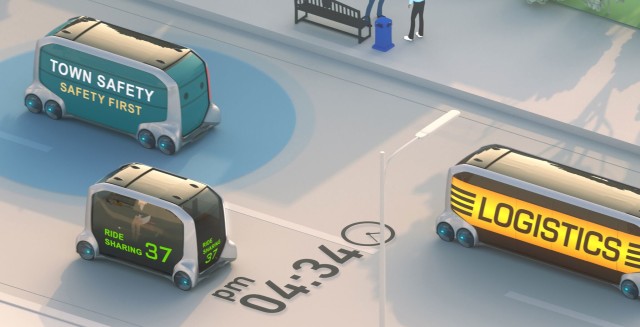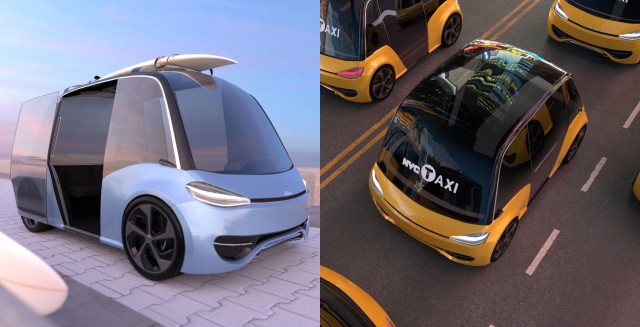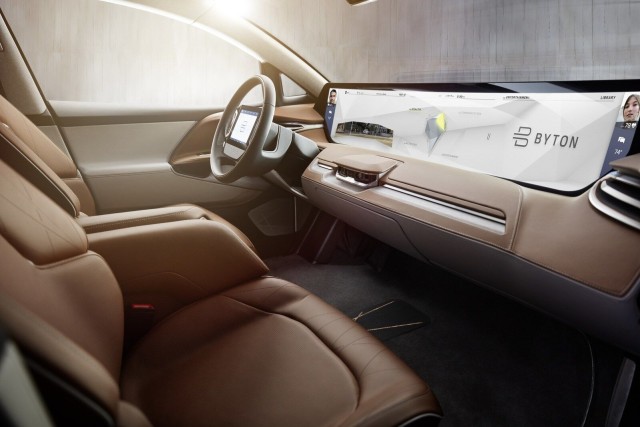CES, the Consumer Electronics Show, has come and gone for another year. A week full of all things consumer electronics, with a perhaps-not-so-surprising-anymore amount of cars. In fact, about 90% of the North Hall of the Las Vegas Convention Center this year was dominated by concept cars and car tech.
It seems car makers are now starting to position their products more like consumer electronics, rather than modes of transport – especially driverless cars. Since the driver is slowly becoming the passenger, as we head towards an uncertain future of autonomous vehicles (AVs), you can see why. If we’re not driving our cars anymore, then I suppose we’re consuming the electronics – or at least, that’s what the car companies seem to be thinking.
Toyota showed off their store-on-wheels, the e-Palette, and Rinspeed with their Snap concept, both of which have a similar modular purpose concept as our very own Roo.

These concepts hint at how companies are looking at new business models (which seem to be the new focus for AVs at this year’s CES) that could be opened up by commercial and personal AVs – a personal vehicle, which becomes a moving shopping pod which then becomes an exercise pod and so on. Keeping costs down by utilising the same components for different purposes is a very common industry strategy (ie VW engines in Audis and Audi engines in Lamborghinis) – and we are seeing it in play again at CES this year.
Meanwhile, ex-Apple and BMW spinoff Future Mobility Corporation demonstrated their new vehicle, named Byton, sporting huge multimedia displays with personalised music and seat configuration.
According to the concepts on display at CES, what we’ll be doing in AVs is all shopping, working, resting and entertaining. We think there’s something missing in this thinking. Looking at the car through the lens of consumer electronics, rather than a mode of transport, means a shift in context and therefore a new understanding of the user experience is required – for the benefit of the design of the vehicle and the journey.
Understanding context, and the user need from that context, will help us to understand what we will actually do in a fully-autonomous vehicle – one of those questions that often comes to our minds first when talking about driverless cars – if we’re not driving, then what are we doing? Even Norman Bel Geddes in his 1940 book Magic Motorways ponders a similar question. As he pointed out, humans will want to do human things, even while driving:
“Human beings, even when at the wheel, are prone to talk, wave to their friends, make love, day-dream, listen to the radio, stare at striking billboards, light cigarettes, take chances. They would not be very human if they abandoned these practices even while driving.”
Bel Geddes sentiment above speaks of the human perspective and what we need from technology. We know that CES is all about showing off and wowing us, which is great fun, but before we show off the latest AR windscreens or Black Mirror-like pizza delivery vehicles – we must first consider the brand new context of the driverless vehicle and the as–yet undiscovered human needs that go with it. We feel this human perspective is missing from most conversations around AVs – a problem we address in our new book Humanising Autonomy: Where Are We Going?
IT’S NOT WHAT CAN, IT’S WHAT SHOULD
Let’s take that earlier question “if we’re not driving, then what are we doing?” as an example. The interior of the vehicle can be approached with somewhat of a clean slate, dropping any legacy features that could hold back the experience, policymakers like NHTSA are even excited by the prospect.
One or two of the things listed by Bel Geddes earlier are being shown off today by manufacturers with their visions of the future at technology shows like CES, certainly in the past three years’ shows.
Stepping into Las Vegas Convention Center’s North Hall this year, it would seem that most people were talking about the same three options in regards to what people will do in AVs: 1) be entertained, 2) do work, and 3) relax or sleep. You could suggest that this thinking is an assumption informed by similar transport offerings, like those presented by train and plane travel.
The industry assumption that the driver-cum-passenger will either want to be entertained, do work or relax, (mis)informed by the likes of other driverless transport, then informs their concepts, which are all starting to look the same. Multimedia displays and augmented reality windshields provide the entertainment and work requirements, while super comfy seats and lounge-like interiors provide rest and relaxation.
Because all we want to do as people is watch TV, sleep, and work… right?
You may be picking up a sense of cynicism reading this, that’s not because we don’t think passengers will be afforded an array of entertainment options – in fact we propose certain entertainment solutions of our own in our book – we just feel that there’s far more potential here, but first – there are far more meaningful human needs than simply being entertained or otherwise distracted.
These ideas seem to still revolve around that fundamentally misleading question of “what can we do with the technology and the space?” taking answers from what we know from current public transport. But what people require from a specific journey varies from vehicle to vehicle (car to train to plane, morning to evening) and also, crucially, from person to person.
What do we actually want? What do we actually need from our journeys? To get to the bottom of the problem, we need to look to users for the answer, not the technology.
OBSERVE, RATHER THAN ASK
“If I had asked people what they wanted, they would have said faster horses.”
A survey published by the Auto Service Center did just that. The survey asked 2,000 people to list the activities they would primarily do during their driverless car commute. The top ten responses were:
- Read a book
- Catch up with friends
- Get work done outside of the office
- Watch a television show
- Watch a movie
- Eat
- Play video games
- Sleep
- Have sex
- Pray
This list does seem to support the industry point of view, with the majority of the answers falling into one of the three categories: 1) be entertained, 2) do work, and 3) relax or sleep. Indeed, many of these, if not all of them, are common in air travel. Even response number nine is a necessity if you want to join the Mile High Club, and airports all over the world have installed multi-faith prayer rooms to facilitate response number ten.
The problem with this survey, and the concepts displayed at events like CES, is that the insights gathered are based on assumption and experiential bias rather than observation of broad and real human behaviour in the real context. The respondents to this survey would not and could not have had the entire context in mind when answering these questions. For example, if the respondents knew that the average time they would spend in these vehicles is likely to be around 15 minutes (according to London taxi and Uber drivers) would they give these same answers?
Even if they were all American commuters, who spend on average 26 minutes driving to work, how much book reading would we do in 26 minutes? How much work? We certainly couldn’t watch a movie in that time.
There’s a difference between asking people in the comfort of their own home and watching them in an actual AV. If we want to find out what we will do, or what we will want to do, in AVs we need to observe what we actually do, in context, over time. Merely asking people will provide subjective presumptions, not truth.
So to answer this question: “if we’re not driving, then what are we doing?” and therefore design for it, we will need to observe what we do in this context. This presents a barrier to adoption. When designing the vehicle itself and its interior, both physically, digitally, and from a service design point of view, getting this wrong will make for an inappropriate user experience and therefore poor adoption – the brand which gets this right is destined to win in this space. To understand the human need here, car makers will need to trial their vehicles, with real users, in real scenarios (or as close as is safely possible), to help guide their design direction.
However Looking beyond entertainment, rest and work, there are perhaps three answers in the Auto Service Center survey that don’t quite fit, and these three represent very real human needs:
- Eat
- Have sex
- Pray
What we see here is the beginnings (repeat, the beginnings) of very real and innate human needs, needs that people seem to feel is important in the context of AV riding, something that otherwise may not have been spotted if the people themselves were not consulted with or observed when designing the AV experience. You could argue that the above three are possible in some autonomous car concepts, granted. However, from our own research projects over the past few years, we’re seeing some further human needs that need to be addressed if the technology is to be adopted. Before we can begin to start thinking about how to show the latest movie, play a favourite album, or provide calendar syncing functionalities, there are very real and very deep human needs that first need to be addressed.
Here we discuss just a handful of the crucial human needs AVs must consider to guarantee adoption. You can find a fuller exploration of these factors in Chapter 10 of of our book “If we’re not driving what are we doing?” – download it for free here.
HUMAN NEED 1: A DRIVER (HUMAN OR OTHERWISE)
One of the major issues we found with driverless cars in our projects is that there’s no driver – we know, no shit right. But imagine getting into a taxi and there’s no driver there. How do you confirm you’re in the right taxi? How do you know the taxi is going to the right place and the right way? Will the car crash?
Children and the elderly we observed believed that the cars would be unsafe without a human driver. In fact, we found that our participants were more comfortable with the term “AI driven car” than they were with “driverless car” – for the simple fact that the terminology suggested there was at least something driving the car. To get there though, many of the things that the presence of a driver brings to the experience must be replaced by the service and user experience of an autonomous journey, these are both practical and emotional.
HUMAN NEED 2: MINIMAL ANXIETY
The complexities of the road make it that much more alarming for those not used to thinking about AVs – and that’s all of us, by the way. Other public transport vehicles travel on tracks, whether physical ones like a train or digital ones like an aeroplane flight path, greatly reducing the complexity. Further, for the most part, trains and planes have that entire stretch of “track” all to themselves, which is clearly not the case for cars in our cities with their congested roads.
That said, AVs will be far safer than a driven taxi, so why would people fear them? Well, it’s quite simple. The perceived risk of danger is, apparently, far greater than if a driver were on board, despite the fact that it will be statistically far safer.
HUMAN NEED 3: THE THIRD PLACE
“I personally think what we know today as cars will change drastically. They will be automotive, you’ll be expecting a completely different interior, and it’s a march not only of mobility and technology, but mobility and third living spaces.”
It’s great to see that these are being considered by some manufacturers at least. Rinspeed CEO Frank Rinderknecht touches on a human need for what is known as the third place, which informed much of Rinspeed’s Oasis AV concept, shown off at CES last year. A concept popularised by Ray Oldenburg in his 1989 book The Great Good Place, the third place refers to another space separate from home (the first place) and work (the second place) which Oldenburg argues is important for civil society, democracy, civic engagement, and establishing feelings of a sense of place, all of which represent very important individual and group human needs. Further, some neuroscientists believe that our need for social interaction is as important as our need for food and water – the third place is vital for the diversity of social interaction we need to be mentally healthy.
Depression is a growing concern in many cities, in part brought on by a feeling of isolation as a result of the autonomation of services all around us. Autonomous vehicles have a responsibility, not just to prevent from contributing to this, but also to cease the opportunity to reverse this.
HUMAN NEED 4: SAFETY
Safety, of course, is one of autonomous vehicles’ major benefits. However, one aspect of safety that has largely remained unexplored is that of personal safety from others when inside the vehicle, ie from robbery or carjacking.
These days you see a lot of smashed car windows, trails of broken glass leading to thieves who have smashed and grabbed valuable pieces of kit to sell on the black market. With the concepts coming out of CES this year, showing off huge HD screens and other forms of high-tech gadgetry, could AVs take us back to the days of highway robbery? There are far more concerning scenarios than theft, however. Having spoken to commuters in Mexico City, we discovered that cars waiting in traffic there are a prime target for carjacking and kidnapping.
In fact, recently The US Department of State published a travel warning to people travelling through parts of Mexico – including Mexico City – for “violent crimes, including homicide, kidnapping, carjacking, and robbery”. If you imagine an autonomous taxi situation, like Mercedes-Benz’s Smart Vision EQ Fortwo concept vehicle revealed at CES, a method potentially used by the elderly who can no longer drive, then these people could be even more vulnerable to these crimes as a result of the advancing technology.
This challenge demonstrates why we need to understand human needs for all social groups and cultural differences with regards to feeling safe on the road. For autonomous vehicle technology to be adopted in big cities like London and Mexico City, autonomous vehicle makers will need to consider and design for safety, not just from accidents, but also from outside forces, such as crime.
WAY MORE THAN A TO B
Traditional cars must all be designed for one specific application: driving. Remove the need for this function and the possibilities suddenly open up. Want to study on the way to school? Sure. Want to do some grocery shopping? Covered. Want to have sex with your partner on the way home? Great!
The future car can accommodate and repurpose itself for all of these situations – we’re seeing the rise of the contextual vehicle, which can be seen in Toyota’s e-Palette concept and Rinspeed’s Snap concept. This is analogous in technology with the implementation of field programmable gate arrays (FPGAs) and processors that can change their hardware on the fly to accommodate different needs. Need more graphical performance? Got it. More machine learning power? Done. These have begun a new wave of contextual computing and are replacing the inefficiencies of application specific chips (ASICs). Cars will move on from being application specific, and the possibilities will be endless, making them capable of being personal and adaptable.
But let’s consider what we really need and want from this technology, our innate human requirements, rather than using technology for technology’s sake. Currently, car makers and tier one and two suppliers are asking “what can we do?” but the real question we should be asking is:
“What are our mobility needs and desires and how can autonomous vehicles support that?”
In this context, what do we need in order to be comfortable and confident riding in a driverless car and therefore adopt this technology? Not only that, but how can this technology integrate into and improve our lives and wellbeing, and what societal responsibilities does the technology hold?
If you’re looking for help to answer these questions, get in touch – mobility@ustwo.com.
You can also read more detailed thinking in our book. Download for free here.
